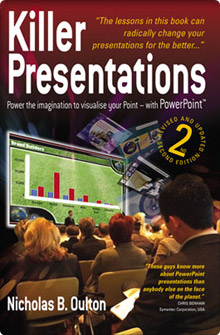Presentation Iconography
If a picture paints a thousand words, why do we use thousands of words and one picture (pie chart!) in our presentations?
When, how and why should we use icons in a visual presentation?
Iconography is often associated with art or religion (Cross, Star of David, Ichthus (little fish shape used by Christians during times of religious persecution now seen on the back of cars) but the idea of using a small image as a symbol has a long tradition.
Modern usage can be blamed on Apple, the mass of computer graphic interfaces needing icons for every application and function at your fingertips. But, in essence the benefit of using icons is that they bypass the language centers of the brain. They speed up information transmission and reduce the amount of cognitive load needed to assimilate information, and idea or concept. Think about using a computer that displays text in a foreign language—on the whole you’d still be able to do quite a bit because the program and function icons all transcend the language barrier.
Iconography in Presentations
An icon is a type of symbol—an age-old way of eliminating the confusion delivered from the imprecise nature of language. In a presentation we use iconography to do four things:

- Allow the simplification of complex ideas. (Build on simple ideas to create more complex ones)
- Avoid confusion
- Speed up information transmission
- Create Visual Cognitive Dissonance (causing the audience to question what the icon represents)
Presentation iconography, when done well, is part of developing a ‘Visual Lexicon’ which is a collection of non-language dependent symbols that convey concepts, ideas or consequences, between presenter and audience. At a basic level that includes:
- Tick marks
- Cross marks
- Company logos
- STOP signs etc
These all work because they reduce cognitive load (mental effort) by bypassing the phonological loop (phonetic rehearsal system inside your head) therefore passing information 100 times faster than text (or speech). Familiar icons like the above are good practice but must be graphically consistent (a series or green ticks followed by a red one will invoke dissonance).
Do You See What I See?
But there are issues, the biggest of which is the assumption that icon meanings are as clear to the audience as they are to the presenter. As with all lexicons, it needs to be shared if it’s to work.
The Ichthus example above started life as a secret symbol, a way of communicating only to the people who knew about it. Many icons are culturally or contextually dependent. For example, in the UK we often use the Lloyds quality logo to represent quality, but across the pond it doesn’t translate.
Some are references that require contextual interpretation. My favorite line in any song is Don Henley’s Boys of Summer, “I saw a dead head sticker (symbol of 60’s hippy anti-establishment movement) on a Cadillac (symbolizing all that Capitalism has to offer.)” While I love everything that line says about life, growing up and the selfishness of age, I tried to explain it to some of my scouts the other day and completely failed, they didn’t get the complex ideas represented by the simple symbols.
The moral to the story is that every time you show an audience an icon or for that matter any kind of symbol, its worth commenting on what it is, what it stands for and how you are using it.
So my top 5 tips for icons are:
- Use as much as you can
- State what they are
- Be contextually consistent
- Be graphically consistent
- Be sensitive (Swastikas can be used to represent lots of ideas but they pretty much always going to offend somebody)

Comments
Pingback: Icons in Presentations | m62
Using simple icons as visual aids is a powerful tool and you should be commended for spreading the idea.
I have to say, though, that I disagree with your reasoning behind it. Some of the psychology you cite to rationalise your choice of symbols is somewhat shoddy and at times just plain contrary to current research. Especially when you discount semantic properties for phonological properties – this is not how current cognitive science assumes your brain recognizes concepts.
So those images do not bypass the language centers of the brain and neither are they more precise than language – in fact they trigger linguistic concepts as soon as the visual information is mapped onto those and in doing so they are actually less precise than a word. It is just this activation of several “meaning entities” or concepts via a different route than linguistic activation that sets them apart from using language alone – they make connecting different meanings a lot easier.
The semantic properties of icons, i.e. the study of which concepts they do trigger and how far this amounts to a semiotic rule that mimics the semiotic principles of language is not a field where you could fall back on a lot of solid evidence, so you’ll have to rely on your experience and common sense. And I would trust your experience much more than any gratuitous reference to (in my opinion) insufficient research, to be honest. After all, the results of your presentation approach are quite convincing.
Hi Jakob,
I suspect part of what you’re objecting to here is Nick’s choice of language (though you — and he — should feel free to correct me here!). I think the contention is really about Nick’s use of the phrase “bypass the language centres of the brain”. You are right that this is not strictly accurate: any information that we process, no matter which route it comes in by, will still recruit the brain’s centres for meaning (semantics) and language (the phonological stuff). When I see the fish icon, my brain is still preparing to say “fish” and thinking about what a fish is (and what that particular representation of” fish” connotes), even if I’m not conscious of that and even if I have no intention of saying the word “fish”.
But it also seems highly likely that visual working memory and phonological working memory are different stores, each with their own capacity, and that you can absorb more information if you use both. So I might be tempted to rephrase Nick’s argument slightly, to something like “we know pictorial/iconographic information is faster to process, and that use of icons minimises the load on phonological working memory for someone listening to the speaker while also looking at the slides”.
Anyway, one or both of you should feel free to disagree with me :o)
Cheers,
Chris
Chris,
thanks for providing your expertise on the subject. Still I have to admit I would not even subscribe to your rephrased version: “faster to process” is a bold claim and I doubt that you could provide conclusive evidence that would point to how fast humans can “understand” concepts to begin with. This question is still part of the black box we cannot yet penetrate with current research methods in my opinion. Plus your claim is counterintuitive to my understanding of how meaning is computed in the vast arrays of networked information stored in the brain.
Now, the enhanced storage capacity sounds more plausible. As does the working load put on processing lanes (if you use the broca region as the sole throughput for information, it makes sense that you are causing a traffic jam – as is exemplified by the impossibility to listen to several conversations simultaneously).
However, the phrases Nick used are rooted in specific theories – the “phonological loop” especially is something I don’t buy. Not only is the theory some 30 years old and flawed in my opinion: in spite of what the Wikipedia entry claims there is very much evidence to the contrary. Semantic priming just being one example. That’s why I was so harsh on the research he pointed to. If you feel could back him up on this none the less I’ll have to make sure to get acquainted with the body of literature I seem to have missed.
Thanks for keeping me on my toes!
Jakob